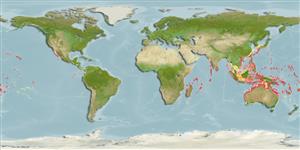Teleostei (teleosts) >
Acanthuriformes (Surgeonfishes) >
Acanthuridae (Surgeonfishes, tangs, unicornfishes) > Nasinae
Etymology: Naso: Latin, nasus = nose (Ref. 45335); tonganus: Named after Tonga, its type locality (Ref. 37792).
More on author: Valenciennes.
Environment: milieu / climate zone / depth range / distribution range
Ecology
Marine; reef-associated; depth range 2 - 40 m (Ref. 86942). Tropical
Western Indian Ocean: Mauritius, Seychelles and Mozambique (probably wider distribution in this part of the ocean).
Size / Weight / Age
Maturity: Lm ? range ? - ? cm
Max length : 60.0 cm SL male/unsexed; (Ref. 37792)
Inhabits coral reefs (Ref. 37792). Feeds on leafy or fleshy algae and zooplankton (Ref. 37792). Found singly or in small groups (Ref. 37792).
Life cycle and mating behavior
Maturity | Reproduction | Spawning | Eggs | Fecundity | Larvae
Randall, J.E., 2001. Surgeonfishes of Hawai'i and the world.. Mutual Publishing and Bishop Museum Press, Hawai'i. 123 p. (Ref. 37792)
IUCN Red List Status (Ref. 130435: Version 2024-1)
Threat to humans
Harmless
Human uses
Fisheries: minor commercial
Tools
Special reports
Download XML
Internet sources
Estimates based on models
Preferred temperature (Ref.
123201): 24.5 - 28.9, mean 27.7 °C (based on 706 cells).
Phylogenetic diversity index (Ref.
82804): PD
50 = 0.5000 [Uniqueness, from 0.5 = low to 2.0 = high].
Bayesian length-weight: a=0.02754 (0.01595 - 0.04755), b=2.97 (2.82 - 3.12), in cm total length, based on LWR estimates for this species & Genus-body shape (Ref.
93245).
Trophic level (Ref.
69278): 2.0 ±0.00 se; based on food items.
Resilience (Ref.
120179): Medium, minimum population doubling time 1.4 - 4.4 years (Preliminary K or Fecundity.).
Fishing Vulnerability (Ref.
59153): Moderate to high vulnerability (49 of 100).
Nutrients (Ref.
124155): Calcium = 33.9 [20.0, 65.5] mg/100g; Iron = 0.527 [0.268, 0.925] mg/100g; Protein = 18.6 [17.4, 19.7] %; Omega3 = 0.114 [0.070, 0.214] g/100g; Selenium = 36.4 [18.8, 66.9] μg/100g; VitaminA = 50.9 [14.8, 166.1] μg/100g; Zinc = 1.47 [1.01, 2.13] mg/100g (wet weight);
